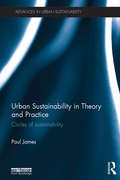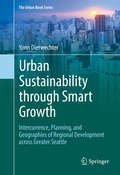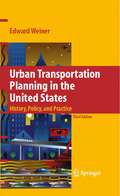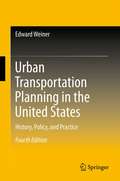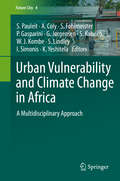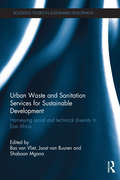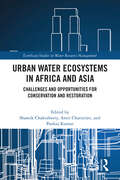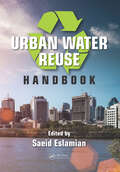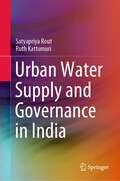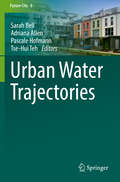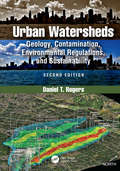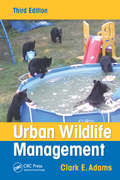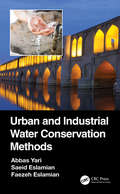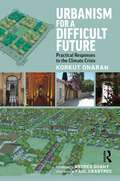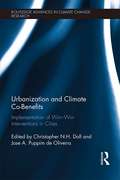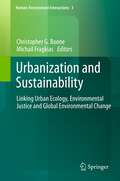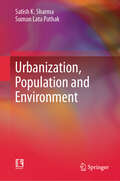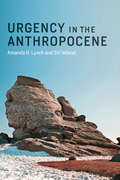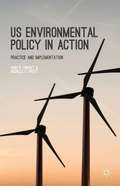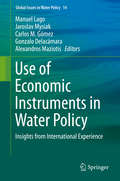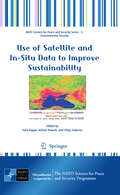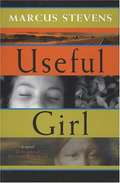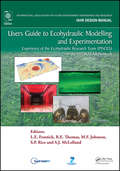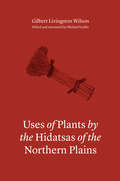- Table View
- List View
Urban Sustainability in Theory and Practice: Circles of sustainability (Advances in Urban Sustainability)
by Paul JamesCities are home to the most consequential current attempts at human adaptation and they provide one possible focus for the flourishing of life on this planet. However, for this to be realized in more than an ad hoc way, a substantial rethinking of current approaches and practices needs to occur. Urban Sustainability in Theory and Practice responds to the crises of sustainability in the world today by going back to basics. It makes four major contributions to thinking about and acting upon cities. It provides a means of reflexivity learning about urban sustainability in the process of working practically for positive social development and projected change. It challenges the usually taken-for-granted nature of sustainability practices while providing tools for modifying those practices. It emphasizes the necessity of a holistic and integrated understanding of urban life. Finally it rewrites existing dominant understandings of the social whole such as the triple-bottom line approach that reduce environmental questions to externalities and social questions to background issues. The book is a much-needed practical and conceptual guide for rethinking urban engagement. Covering the full range of sustainability domains and bridging discourses aimed at academics and practitioners, this is an essential read for all those studying, researching and working in urban geography, sustainability assessment, urban planning, urban sociology and politics, sustainable development and environmental studies.
Urban Sustainability through Smart Growth
by Yonn DierwechterThis book investigates the new urban geographies of "smart" metropolitan regionalism across the Greater Seattle area and examines the relationship between smart growth planning strategies and spaces of work, home, and mobility. The book specifically explores Seattle within the wider space-economy and multi-scaled policy regime of the Puget Sound region as a whole, 'jumping up' from questions of city politics to concerns with what the book interprets as the "intercurrence" of city-regional "ordering. " These theoretical terms capture the state-progressive effort to promote smarter forms of regional development but also the societal/institutional tensions and outright contradictions that such urban development invariably entails, particularly around problems of social equity. Key organizing themes in the text include: the historical path-dependencies of uneven economic and social development, particularly between Tacoma-Pierce County and Seattle-King County; current patterns of high-wage, medium-wage, and low-wage jobs; the emerging spatial and social structure of recent residential changes, especially with respect to class and race composition; and, finally, transit trends and new urban spaces associated with policy efforts to mitigate highway congestion and car-dependency. Greater Seattle, then, is mapped as a key US urban region inscribed spatially by the uneven search for a more sustainable order. Historically-sensitive, theoretically-informed and empirically topical, this book is of interest to scholars and students at all levels in regional planning, urban geography, political science, sustainability studies, urban sociology and public policy.
Urban Transportation Planning in the United States: History, Policy, and Practice, 3rd Edition
by Edward WeinerThe development of U.S. urban transportation policy over the past 50 years illustrates the changing relationships among federal, state, and local governments. This comprehensive text examines the evolution of urban transportation planning from early developments in highway planning in the 1930s to today's concerns over sustainable development, security, and pollution control. Focusing on major national events, the book discusses the influence of legislation, regulations, conferences, federal programs, and advances in planning procedures and technology. The book focuses in-depth at the most significant event in transportation planning--the Federal-Aid Highway Act of 1962; creating a federal mandate for a comprehensive urban transportation planning process carried out cooperatively by states and local governments with federal funding, this act was crucial in the spread of urban transportation. Claiming that urban transportation planning is more sophisticated, costly, and complex than its highway and transit planning predecessors, the book demonstrates how urban transportation planning evolved in response to changes in such factors as environment, energy, development patterns, intergovernmental coordination, and federal transit programs. It further illustrates how broader concerns for global climate change and sustainable development have braided the purview of transportation planning. This fully updated, revised, and expanded edition highlights the dynamics of transportation planning post-9/11, covers the impact of recent legislation, emphasizes such timely issues as security, oil dependence, performance measurement, and public-private sector collaboration.
Urban Transportation Planning in the United States: History, Policy, and Practice, 4th Edition
by Edward WeinerThe development of U.S. urban transportation policy over the past 50 years illustrates the changing relationships among federal, state, and local governments. This comprehensive text examines the evolution of urban transportation planning from early developments in highway planning in the 1930s to today's concerns over sustainable development, security, and pollution control. Focusing on major national events, the book discusses the influence of legislation, regulations, conferences, federal programs, and advances in planning procedures and technology. The book focuses in-depth at the most significant event in transportation planning--the Federal-Aid Highway Act of 1962; creating a federal mandate for a comprehensive urban transportation planning process carried out cooperatively by states and local governments with federal funding, this act was crucial in the spread of urban transportation. Claiming that urban transportation planning is more sophisticated, costly, and complex than its highway and transit planning predecessors, the book demonstrates how urban transportation planning evolved in response to changes in such factors as environment, energy, development patterns, intergovernmental coordination, and federal transit programs. It further illustrates how broader concerns for global climate change and sustainable development have braided the purview of transportation planning. This fully updated, revised, and expanded edition highlights the dynamics of transportation planning post-9/11, covers the impact of recent legislation, emphasizes such timely issues as security, oil dependence, performance measurement, and public-private sector collaboration.
Urban Vulnerability and Climate Change in Africa
by Paolo Gasparini Stephan Pauleit Adrien Coly Sandra Fohlmeister Gertrud Jørgensen Sigrun Kabisch Wilbard J. Kombe Sarah Lindley Ingo Simonis Kumelachew YeshitelaUrbanisation and climate change are among the major challenges for sustainable development in Africa. The overall aim of this book is to present innovative approaches to vulnerability analysis and for enhancing the resilience of African cities against climate change-induced risks. Locally adapted IPCC climate change scenarios, which also consider possible changes in urban population, have been developed. Innovative strategies to land use and spatial planning are proposed that seek synergies between the adaptation to climate change and the need to solve social problems. Furthermore, the book explores the role of governance in successfully coping with climate-induced risks in urban areas. The book is unique in that it combines: a top-down perspective of climate change modeling with a bottom-up perspective of vulnerability assessment; quantitative approaches from engineering sciences and qualitative approaches of the social sciences; a novel multi-risk modeling methodology; and strategic approaches to urban and green infrastructure planning with neighborhood perspectives of adaptation.
Urban Waste and Sanitation Services for Sustainable Development: Harnessing Social and Technical Diversity in East Africa (Routledge Studies in Sustainable Development)
by Bas Van Vliet Joost Van Buuren Shaaban MganaUrban sanitation and solid waste sectors are under significant pressure in East Africa due to the lack of competent institutional capacity and the growth of the region’s urban population. This book presents and applies an original analytical approach to assess the existing socio-technical mixtures of waste and sanitation systems and to ensure wider access, increase flexibility and ecological sustainability. It shows how the problem is not the current diversity in waste and sanitation infrastructures and services and variety of types and scales of technology, of formal and informal sector involvement, and of management and ownership modes. The book focuses instead on the lack of an integrative approach to managing and upgrading of the various waste and sanitation configurations and services so as to ensure wider access, flexibility and sustainability for the low income populations who happen to be the main stakeholders. This approach, coined "Modernized Mixtures", serves as a nexus throughout the book. The empirical core addresses the waste and sanitation challenges and debates at each scale - from the micro-level (households) to the macro-level (international support) - and is based on the results of a five-year-long interdisciplinary, empirical research program. It assesses the socio-technical diversity in waste and sanitation and provides viable solutions to sanitation and waste management in East Africa. This book provides students, researchers and professional in environmental technology, sociology, management and urban planning with an integrated analytical perspective on centralized and decentralized waste and sanitation configurations and tools for improvement in the technology, policy and management of sanitation and solid waste sectors.
Urban Water Cycle Processes and Interactions: Urban Water Series - UNESCO-IHP (Urban Water Series)
by Jiri MarsalekUrban Water Cycle Processes and Interactions represents the fruit of a project by UNESCO's International Hydrological Programme on this topic. The volume introduces the urban water cycle concept and the need for integrated or total management. It then explores in detail the manifold hydrological components of the cycle, the diverse elements of urban infrastructure and water services, and the various effects of urbanization on the environment - from the atmosphere and surface waters to wetlands, soils and groundwater, as well as biodiversity. A concluding series of recommendations for effective urban water management summarize the important findings set forth here.
Urban Water Ecosystems in Africa and Asia: Challenges and Opportunities for Conservation and Restoration (Earthscan Studies in Water Resource Management)
by Amit Chatterjee Shamik Chakraborty Pankaj KumarThis book examines urban water ecosystem management and restoration through selected case studies in Asia and Africa. Employing a socioecological approach, this volume presents insights on the interlinkages between water, humans, and environmental conservation in an urban context.Topics include human health risks, population displacement and migration, water pollution, water scarcity, flood management, water infrastructure, afforestation, and the effects of climate change. Case studies are drawn from a variety of countries in Africa and Asia, including China, Japan, India, Vietnam, Bangladesh, Kenya, Malawi, and Tunisia, which demonstrate a wide range of different challenges, and opportunities. Overall, this book argues that to better manage urban water resources, there needs to be a shift from urban water management to urban water ecosystem management. This shift needs to acknowledge the complex biophysical and socio-political dimensions of water ecosystems.This book will be of great interest to students and scholars of water resource management, ecosystem services, urban studies, environmental conservation and sustainable development.
Urban Water Reuse Handbook
by Saeid EslamianExamining the current literature, research, and relevant case studies, presented by a team of international experts, the Urban Water Reuse Handbook discusses the pros and cons of water reuse and explores new and alternative methods for obtaining a sustainable water supply. The book defines water reuse guidelines, describes the historical and curren
Urban Water Supply and Governance in India
by Ruth Kattumuri Satyapriya RoutThis book investigates institutional dimensions of urban water supply in India, with a specific focus on institutional capabilities to provide drinking water to urban households in an efficient, equitable and sustainable manner. This book has been developed through empirical research within the context of growing urbanisation and increasing water needs of Indian cities, and the wider developmental goal of achieving universal and equitable access to safe and affordable water for all – as envisaged in goal 6 of the SDGs.This study revolves around three important aspects of urban water supply and governance. Firstly, it attempts to understand household water service delivery scenarios in urban India, drawing from case studies based on our household survey in four cities – Ahmedabad, Bangalore, Kochi and Hyderabad. Secondly, it examines the question of existing socio-economic inequality and access to water in an urban context in India. While dealing with the issue of inequality and access to water, it attempts to explore the question of whether access to water and water scarcity is socially neutral; whilst also analysing the mechanisms employed by the urban poor to manage their daily water needs. Thirdly, this book explores the role of institutions for efficient and effective delivery of water in urban India. The institutional analysis from a comparative perspective provides important insights to guide current reforms in domestic water supply in India, especially in a neo-liberal context. The book is a valuable resource for academicians, policy makers and practitioners involved in water governance in general and domestic (drinking) water supply in particular. Besides, it is of great interest to those working in the area of urban development, urban planning and household water management. The book is an outcome of a collaborative research project by the authors sponsored jointly by University Grants Commission (UGC), New Delhi and UK-India Education and Research Initiative (UKIERI).
Urban Water Trajectories
by Sarah Bell Adriana Allen Pascale Hofmann Tse-Hui TehWater is an essential element in the future of cities. It shapes cities' locations, form, ecology, prosperity and health. The changing nature of urbanisation, climate change, water scarcity, environmental values, globalisation and social justice mean that the models of provision of water services and infrastructure that have dominated for the past two centuries are increasingly infeasible. Conventional arrangements for understanding and managing water in cities are being subverted by a range of natural, technological, political, economic and social changes. The prognosis for water in cities remains unclear, and multiple visions and discourses are emerging to fill the space left by the certainty of nineteenth century urban water planning and engineering. This book documents a sample of those different trajectories, in terms of water transformations, option, services and politics. Water is a key element shaping urban form, economies and lifestyles, part of the ongoing transformation of cities. Cities are faced with a range of technical and policy options for future water systems. Water is an essential urban service, but models of provision remain highly contested with different visions for ownership of infrastructure, the scale of provision, and the level of service demanded by users. Water is a contentious political issue in the future of cities, serving different urban interests as power and water seem to flow in the same direction. Cities in Africa, Asia, Australia, Europe and South America provide case studies and emerging water challenges and responses. Comparison across different contexts demonstrates how the particular and the universal intersect in complex ways to generate new trajectories for urban water.
Urban Watersheds: Geology, Contamination, Environmental Regulations, and Sustainability, Second Edition
by Daniel T. RogersUnderstanding that the natural world beneath our feet is the point at which civilization meets the natural world is critical to the success of restoration and prevention efforts to reduce contaminant impacts and improve the global environment because of one simple fact – contaminants do not respect country borders. Contaminants often begin their destructive journey immediately after being released and can affect the entire planet if the release is in just the right amount, at just the right location, and at just the right time. Taking an interdisciplinary approach, Urban Watersheds, Geology, Contamination, Environmental Regulations, and Sustainability, Second Edition presents more than 30 years of research and professional practice on urban watersheds from the fields of environmental geology, geochemistry, risk analysis, hydrology, and urban planning. The geological characteristics of urbanized watersheds along with the physical and chemical properties of their common contaminants are integrated to assess risk factors for soil, groundwater, and air. This new edition continues to examine the urban environment and the geology beneath urban areas, evaluates the contamination that affects watersheds in urban regions, and addresses redevelopment strategies. Features of the Second Edition: Examines contaminants and the successes of environmental regulation worldwide and highlights the areas that need improvement Describes several advances in investigation techniques in urban regions that now provide a huge leap forward in data collection, resolution, and accuracy Explains the importance of understanding the geological and hydrogeologic environments of urban and developed regions Provides new and enhanced methods presented as a sustainability model for assessing risks to human health and the environment from negative human-induced contaminant impacts Includes a new chapter that surveys how environmental regulations have been successful or have failed at protecting the air, water, and land in urban areas Suitable for use as a textbook and as a professional practice reference, the book includes case studies on successful and unsuccessful approaches to contaminant remediation as well as practical methods for environmental risk assessment. PowerPoint® presentations of selected portions of the book are available with qualifying course adoption. Daniel T. Rogers is currently the Director of Environmental Affairs at Amsted Industries Inc. in Chicago, Illinois. His writings address environmental geology, hydrogeology, geologic vulnerability and mapping, contaminant fate and transport, urban geology, environmental site investigations, contaminant risk, brownfield redevelopment, and sustainability. He has taught geology and environmental chemistry at Eastern Michigan University and the University of Michigan.
Urban Wildlife Management
by Clark E. AdamsWinner of the 2018 TWS Wildlife Publication Awards in the authored book category Urban development is one of the leading worldwide threats to conserving biodiversity. In the near future, wildlife management in urban landscapes will be a prominent issue for wildlife professionals. This new edition of Urban Wildlife Management continues the work of its predecessors by providing a comprehensive examination of the issues that increase the need for urban wildlife management, exploring the changing dynamics of the field while giving historical perspectives and looking at current trends and future directions. The book examines a range of topics on human interactions with wildlife in urbanized environments. It focuses not only on ecological matters but also on political, economic, and societal issues that must be addressed for successful management planning. This edition features an entirely new section on urban wildlife species, including chapters on urban communities, herpetofauna, birds, ungulates, mammals, carnivores, and feral and introduced species. The third edition features Five new chapters 12 updated chapters Four new case studies Seven new appendices and species profiles 90 new figures A comprehensive analysis of terrestrial vertebrate locations by state and urban observations Each chapter opens with a set of key concepts which are then examined in the following discussions. Suggested learning experiences to enhance knowledge conclude each chapter. The species profiles cover not only data about the animal concerned but also detail significant current management issues related to the species. An updated and expanded teaching tool, Urban Wildlife Management, Third Edition identifies the challenges and opportunities facing wildlife in urban communities as well as factors that promote or threaten their presence. It gives both students and professionals a solid grounding in the required fundamental ecological principles for understanding the effects of human-made environments on wildlife.
Urban and Industrial Water Conservation Methods
by Saeid Eslamian Faezeh Eslamian Abbas YariUrban and Industrial Water Conservation Methods provides comprehensive and practical information regarding water use for various different sectors and describes the most suitable conservation devices and techniques to reduce water consumption in urban environments. It demonstrates how these conservation devices and best practices can greatly and quickly increase the efficiency of water use in both new and existing buildings. Features: Examines conservation devices and techniques across residential, commercial, and institutional sectors. Provides practical advice on implementing water conservation methods for users across various industries. Explains how to quickly improve water efficiency by using cost-effective water-saving devices and techniques. Includes relevant international case studies to reinforce the content. Written by practicing water conservation consultants for a wide audience, including municipality authorities and decision-makers, researchers, and students alike, Urban and Industrial Water Conservation Methods applies to residential, commercial, institutional, and industrial end users.
Urbanism for a Difficult Future: Practical Responses to the Climate Crisis
by Korkut OnaranUrbanism for a Difficult Future: Practical Responses to the Climate Crisis is a much-needed guide to launching the next generation of land use planning and urbanism that will enable us to adapt to and survive the consequences of climate change. The book offers strong, straightforward measures for creating a landscape of resilience via pockets of self-sufficiencies. It demonstrates how to secure systems that sustain life (energy, water, food, waste, and production of essential goods) as well as political and social protocols enabling agile decision-making in managing these systems effectively at local levels. It also provides the design principles for creating a built environment that will enable the kind of localization we need for adaptation. The book explores how it is possible to create a life that does not depend on large-scale regional sustenance systems which are likely to be disrupted or fail. This book uncovers how to enable people to be creative, productive, and supportive at local levels, so that we can achieve strong and diverse local economies that can sustain life. It will appeal to students, planners, and policy makers working in environmental studies, environmental engineering, urban and regional planning, architecture, landscape architecture, and urbanism.
Urbanization and Climate Co-Benefits: Implementation of win-win interventions in cities (Routledge Advances in Climate Change Research)
by Christopher N.H. Doll and Jose A. Puppim de OliveiraUrban areas are increasingly contributing to climate change while also suffering many of its impacts. Moreover, many cities, particularly in developing countries, continue to struggle to provide services, infrastructure and socio-economic opportunities. How do we achieve the global goals on climate change and also make room for allowing global urban development? Increasing levels of awareness and engagement on climate change at the local level, coupled with recent global agreements on climate and development goals, as well as the New Urban Agenda emerging from Habitat III, present an unprecedented opportunity to radically rethink how we develop and manage our cities. Urbanization and Climate Co-Benefits examines the main opportunities and challenges to the implementation of a co-benefits approach in urban areas. Drawing on the results of empirical research carried out in Brazil, China, Indonesia, South Africa, India and Japan, the book is divided into two parts. The first part uses a common framework to analyse co-benefits across the urban sectors. The second part examines the tools and legal and governance perspectives at the local and international level that can help in planning for co-benefits. This book will be of great interest to students, practitioners and scholars of urban studies, climate/development policy and environmental studies.
Urbanization and Sustainability
by Christopher G Boone Michail FragkiasCase studies explore the Million Trees initiative in Los Angeles; the relationship of cap-and-trade policy, public health, greenhouse gas emissions and environmental justice in Southern California; Urbanization, vulnerability and environmental justice in the Brazilian cities of Rio de Janeiro, Curitiba and São Paulo, and in Antofagasta, Greater Concepción and Valparaiso in Chile; Sociospatial patterns of vulnerability in the American southwest; and Urban flood control and land use planning in Greater Taipei, Taiwan ROC.
Urbanization, Population and Environment
by Satish K. Sharma Suman Lata PathakThe volume explores the intricate relationship between urbanization, population dynamics, and the environment in the western Himalayas from a historical perspective. It challenges the conventional link that urban development is solely tied to population growth, unveiling the influence of political and economic elites. Through empirical analysis within a historical context, the study unveils the significance of cantonment towns, military consolidation, and legislative control in driving urban growth. While it leads to population surges, economic activities, and improvements in transportation and communication, it also exposes adverse effects like the overuse of forest resources, disrupting the balance between humans and nature, and leading to ecological imbalances and fatalities. This volume opens new avenues for research on rivers, biodiversity, geopolitics, socio-cultural aspects, and the economy but also offers valuable insights for national and international academia.
Urgency in the Anthropocene
by Amanda H. Lynch Siri VelandA proposal to reframe the Anthropocene as an age of actual and emerging coexistence with earth system variability, encompassing both human dignity and environmental sustainability. Is this the Anthropocene, the age in which humans have become a geological force, leaving indelible signs of their activities on the earth? The narrative of the Anthropocene so far is characterized by extremes, emergencies, and exceptions—a tale of apocalypse by our own hands. The sense of ongoing crisis emboldens policy and governance responses that challenge established systems of sovereignty and law. The once unacceptable—geoengineering technology, for example, or authoritarian decision making—are now anticipated and even demanded by some. To counter this, Amanda Lynch and Siri Veland propose a reframing of the Anthropocene—seeing it not as a race against catastrophe but as an age of emerging coexistence with earth system variability. Lynch and Veland examine the interplay between our new state of ostensible urgency and the means by which this urgency is identified and addressed. They examine how societies, including Indigenous societies, have understood such interplays; explore how extreme weather and climate weave into the Anthropocene narrative; consider the tension between the short time scale of disasters and the longer time scale of sustainability; and discuss both international and national approaches to Anthropocene governance. Finally, they argue for an Anthropocene of coexistence that embraces both human dignity and sustainability.
Us Environmental Policy In Action
by Sara R. Rinfret Michelle C. PautzUS Environmental Policy provides a comprehensive look at the creation, implementation, and evaluation of environmental policy, which is of particular importance in an era of congressional gridlock.
Use of Economic Instruments in Water Policy
by Manuel Lago Jaroslav Mysiak Carlos M. Gómez Gonzalo Delacámara Alexandros MaziotisThis book assesses both the effectiveness and efficiency of implemented Economic Policy Instruments (EPIs) in order to achieve water policy goals and identifies the preconditions under which they outperform alternative (e. g. regulatory) policy instruments and/or can complement them as part of complex policy mixes. The development of a consolidated assessment framework helps clarify (and where possible, quantify) the effectiveness of each EPI on the basis of different criteria. Outcome-oriented criteria describe how the EPIs perform. They include intended and unintended economic and environmental outcomes and the distribution of benefits and costs among the affected parties. These steps consider the application of cost effectiveness and cost benefits analysis, e. g. to assess ex-post performance of the EPI. Process criteria describe the institutional conditions (legislative, political, cultural, etc. ) affecting the formation and operation of the EPI studied (particularly relevant for assessing the possible impacts of using economic instruments), the transaction costs involved in implementing and enforcing the instruments and the process of implementation. Case studies from Cyprus, Denmark, France, Germany, Hungary, Italy, the Netherlands, Spain and the United Kingdom, as well as from Australia, Chile, Israel and the USA are presented in this book. A wide variety of EPIs are also covered, including water-pricing schemes (tariffs, environmental taxes, environmental charges or fees, subsidies on products and practices), trading schemes (tradable permits for abstraction and pollution) and cooperation mechanisms.
Use of Satellite and In-Situ Data to Improve Sustainability
by Alfred Powell Felix Kogan Oleg FedorovMore than 30-year operational satellite data have already been used for monitoring land, ocean and atmosphere. These applications have contributed to improve sustainable economy, produce healthy environment and enhance human life. The Advanced Research Workshop sponsored by NATO and organized by the USA's National Oceanic and Atmospheric Administration and Ukrainian's Space Agency bring the scientists with the most mature research designed for practical use. The goals were to select those which is used for services today and identify the areas to expand research and services. Scientific and application results of the Workshop presented in this book can be used today in agriculture, forestry, water resources, healthy coastal life and fisheries, climate and land cover change, anthropogenic activities and others. The presented papers provide information on how to use operational satellites and in situ measurements for early detection of large-scale droughts, floods and fires, diagnose crop and pasture annual losses, predict periods with health/unhealthy vegetation based on such climate forcing events as ENSO, monitor air quality and geomagnetic activities, assess land cover trends in responce to global warming etc. The available satellite/ground information and method is currently warn with a lead time sufficient to respond, recover and protect.
Useful Girl
by Marcus StevensAfter her mother's sudden death, Erin Douglass is virtually alone in the world. When she witnesses the exhumation of a Cheyenne girl along the side of a dirt road, life in her Montana town indelibly changes. The girl's remains, gently wrapped in a faded army coat, with silver thimbles on her right hand, are more than a hundred years old. Though her father makes every attempt to keep the discovery quiet, Erin is haunted by questions: how did this young girl end up here, in the middle of nowhere, with no marker and all alone? Who was she?
Users Guide to Ecohydraulic Modelling and Experimentation: Experience of the Ecohydraulic Research Team (PISCES) of the HYDRALAB Network (IAHR Design Manual)
by L. E. Frostick S. J. McLelland R. E. Thomas M. F. Johnson S. P. RiceUsers Guide to Ecohydraulic Modelling and Experimentation has been compiled by the interdisciplinary team of expert ecologists, geomorphologists, sedimentologists, hydraulicists and engineers involved in HYDRALAB IV, the European Integrated Infrastructure Initiative on hydraulic experimentation which forms part of the European Community‘s Seventh F
Uses of Plants by the Hidatsas of the Northern Plains
by Gilbert Livingston Wilson Michael ScullinIn 1916 anthropologist Gilbert L. Wilson worked closely with Buffalobird-woman, a highly respected Hidatsa born in 1839 on the Fort Berthold Reservation in western North Dakota, for a study of the Hidatsas’ uses of local plants. What resulted was a treasure trove of ethnobotanical information that was buried for more than seventy-five years in Wilson’s archives, now held jointly by the Minnesota Historical Society and the American Museum of Natural History in New York City. Wilson recorded Buffalobird-woman’s insightful and vivid descriptions of how the nineteenth-century Hidatsa people had gathered, prepared, and used the plants and wood in their local environment for food, medicine, smoking, fiber, fuel, dye, toys, rituals, and construction. From courtship rituals that took place while gathering Juneberries, to descriptions of how the women kept young boys from stealing wild plums as they prepared them for use, to recipes for preparing and cooking local plants, Uses of Plants by the Hidatsas of the Northern Plains provides valuable details of Hidatsa daily life during the nineteenth century.
